Ballywilliam
Houses within 15km of this house
Displaying 51 houses.
Houses within 15km of Ballywilliam
Displaying 51 houses.
| House name | Description | |
|---|---|---|
| Massy Lodge | This house is named Massy House on the first Ordnance Survey map and was the main residence of Lord Massy in the first decade of the 19th century. In 1814 Anglesborough was occupied by Hugh Toutstone [Touchstone]. Lewis describes Massy Lodge as the elegant residence of Lord Massy. At the time of the first Ordnance Survey Massy Lodge was the residence of Robert Harding. It was held by Lord Massy in fee at the time of Griffith's Valuation and valued at £24+. The partly demolished house is now owned by the Hanly family. |

|
| Loughananna | At the time of Griffith's Valuation a house at Loughananna was occupied by James McGrath, valued at £10+ and situated on the Kingston estate. By 1906 the mansion house at Loughananna was valued at £50+ and Abel Buckley is recorded as the occupier. | |
| Ballyclogh [Ballyclough] | This property was inherited by the Barrys through marriage with a member of the Purdon family. Parts of this house may have dated from the 17th century. Lewis writes of "a handsome mansion in the Elizabethan style". Additions were made in the 19th century. At the time of Griffith's Valuation it was valued at £34 and held by James Barry in fee. The house was burnt in the 1920s. The north wing survived, built 1904. In 1944 the Irish Tourist Association survey noted that Ballyclough was the birthplace of Sir Redmond Barry, "prominent in public life in the state of Victoria, Australia". It was restored and is still a residence. |
![Photo of Ballyclogh [Ballyclough]](https://landedestates.ie/storage/img/orig/1568.jpg)
|
| Downing | This was the home of the Hendley family in the 19th century. Robert Hendley was the occupier in 1814 and Arthur Henly in the early 1850s. Arthur Henly held the property in fee and the buildings were valued at £9.5 shillings. | |
| Ballinwillin | Lewis writes that this house was the occasional residence of the agent to Lord Kingston, reputedly built by Arthur Young who came to Mitchelstown in the 1770s as a land agent. In the mid 19th century Neale Brown was the occupant holding the house valued at £22.15 shillings and 13 acres from the Earl of Kingston. This house is still a well maintained residence. |

|
| Mitchelstown Castle | The original castle belonged to the FitzGibbons, the White Knight. It passed through the marriage of Margaret FitzGibbon and Sir William Fenton to the heirs of their daughter, Catherine, and her husband, Sir John King. By the mid 18th century the Kings had replaced the castle by a house which was altered and extended over the years. In 1786 Wilson refers to it as "the very magnificent seat of Lord Kingsborough". In the 1820s the 3rd Earl built a new castle in anticipation of a visit from George IV which never happened. This was a huge building in the Gothic Revival style, valued at £180 in the mid 19th century. It remained in the possession of the Kings until the death of Lady Kingston, widow of the 5th Earl. In 1922 the castle was looted and burnt and the stones were later used to build a church at Mount Melleray. In 1943 the Irish Tourist Association Survey provided a detailed description of the castle and its history and noted that portion of the cellars and foundations were still visible. |

|
| Kilbarry (Castlelyons) | Hajba writes that a new house was built here in 1842 by the Wigmores. Robert Wigmore was resident in 1814, E[dward] Wigmore in 1837 and Henry Wigmore in the early 1850s when the buildings were valued at £23 and held in fee. In 1786, Wilson states that it was the residence of Hon. Mr. Moore. Later the home of the Kent and Waters families. Still extant and occupied. |

|
| Maryville | The home of Laurence Corban in 1837 when Lewis records it as “ a handsome mansion of recent erection and finely situated on the Funcheon [River]”. Laurence Corban held Maryville House and the mills in perpetuity at the time of Griffith's Valuation. The house was valued at £32 and the mills complex at £160. The Lucas family succeeded to this property and Hajba writes that it became the dower house for nearby Ballynacarriga. The Irish Tourist Association surveyor in the 1940s reported that it was then occupied by Mr. Glass, an agricultural instructor. In 1965 the house was sold by the Corban Lucas family. It remains a family residence. | |
| Ballynacarriga | A mid 18th century house, home of the Pyne family for over a century until they sold it in the Encumbered Estates' Court in 1852. Before the sale John G. Pyne was resident, holding the property in perpetuity. The buildings were valued at £18.10 shillings. Bought by Laurence Corban it passed from the Pynes to the Corban Lucas family, members of whom were still resident at the beginning of the 21st century. |

|
| Careysville | Careysville Castle, originally known as Ballymacpatrick Castle, was the seat of the Carey family from the late 17th century. In 1750 Careysville was occupied by John Carey and Peter Carey was resident in 1814. In 1837 Lewis refers to “the handsome modern mansion built on the site of Careysville castle” by E.K. Carey. Valued at £50 in the mid 19th century the Careys held this property in fee. Inherited by the Montgomerys of Killee and sold by them to the Duke of Devonshire in the mid 20th century. In 1942 the Irish Tourist Association Survey noted that the house was then unoccupied as Captain Montgomery had moved into a modern bungalow nearby. Careysville is now in use as a fishing lodge offering luxury accommodation. |

|
| Moorepark | A large Georgian house, the seat of the Earls of Mountcashell, extended in the 19th century. In 1786 Wilson describes it as "a superb and noble seat". It was held in fee at the time of Griffith's Valuation when it was valued at £87. Bought by the War Department in 1903 and accidentally burnt in 1908. In 1944 the Irish Tourist Association Survey noted that the remains of the kitchen were still visible then. Nothing remains of the original house and the site now belongs to Teagasc, the Agricultural and Food Development Authority. | |
| Glandulane House | Robert Briscoe had a house and flour mill in the townland of Clondulane North in the mid 19th century, which he held from the Earl of Mountcashel. The house was valued at £25.10 shillings and a flour mill at £96. Later the home of the Hallinans and the O'Donnells. A house is still extant at the site but the mill buildings are now ruinous. |

|
| Mountrivers | This house was a Hendley home in the 18th and 19th centuries, occupied by Mathers Hendley in 1814 and Mattias Hendley in 1837. Mattias C. Hendley was resident in the early 1850s. He held the property in fee and the buildings were valued at £27. The Hendleys contined to reside at Mountrivers until the 1930s and the house is still occupied. |
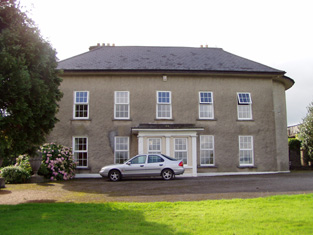
|
| Killee | The seat of the Montgomery family from the mid 18th century, occupied by George Montgomery in 1814 and by William Quinn Montgomery in the early 1850s. It was held in fee at this time and valued at £43. Killee remained in Montgomery possession until the 1930s. It is still occupied. |

|
| Rushmount | Located on the Mountcashell estate this house was occupied by Daniel Gearan in the early 1850s, when it was valued at £19. It remained in the possession of the Gearan/O'Geran family for the rest of the 19th century. |
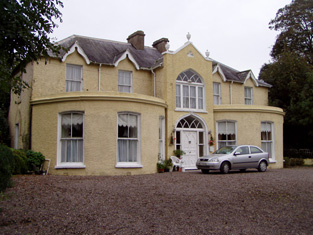
|
| Douglas House | Occupied by Henry Deece in 1837 and by Lady Mountcashell in the early 1850s. Held from the Earl of Mountcashel and valued at £16.10 shillings. Later the home of the Magniers and still a residence. |
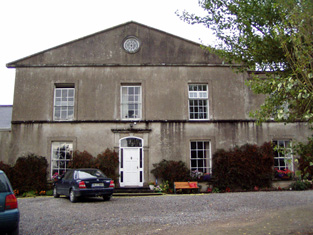
|
| Woodview | Occupied by Lieutenant F.Prangnall RN in 1837 and held by the Earl of Mountcashel in fee at the time of Griffith's Valuation when it was valued at £16. 5 shillings. Later occupied by the Smithwick and by the Lucas family in the 20th century until a fire in the 1930s. Recently restored and occupied again. | |
| Glansheskin | Occupied by John P. Pierse in the mid 19th century. He held the property valued at £19+ from the Earl of Mountcashel with a cornmill valued at £20. Later the property of the Cooke Collis family, this house is still occupied. | |
| Broomhill | Valued at £11, occupied by James Geran and held from James N. Cronin at the time of Griffith's Valuation. Later the home of a member of the Montgomery family and still inhabited. | |
| Cloonkilla | James H. Mandeville held buildings valued at £21 from James N. Cronin among the woods at Cloonkilla at the time of Griffith's Valuation. | |
| Park House | Hajba writes that David Richard Pigot, Chief Baron of Ireland 1846-1873, was born at Park House in 1797. He was the son of Dr John Pigot and Margaret Nagle and married Catherine Paye [Page in DNB] of the nearby Araglin Mills. Th house was valued at £7.10 shillings in the early 1850s and was occupied by the Reverend James Daly, who held it from William Byrne. The Pigotts continued to own this property until at least the late 19th century. Occupied by the Howard family in the 20th century. The Irish Tourist Association Survey notes that it was also referred to as "Rock House". The survey also refers to another house owned by the Pigot family on the main street in Kilworth. | |
| Kilmurry | The house was built in the early 18th century and remained in the hands of the Grant family until sold to the Rosminian Order in the 1930s. In the 1940s the Irish Tourist Association surveyor was given to understand that the Grants still retained title to the property and were residing in South Africa. In the mid 19th century it was valued at £37 and held by Thomas St John Grant in fee. At the beginning of the 21st century this house was in a dilapidated state. |
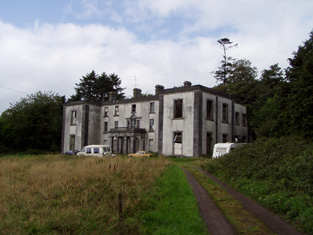
|
| Knockatrasnane | At the time of Griffith's Valuaiton, William Collis held in fee a house and offices valued at £14.10 shillings in this townland. The 1st edition Ordnance Survey map indicates a nursery at this site. The remains of the buildings are still extant. | |
| Castle Cooke | A house was located here from the 17th century. Originally home of the Cooke family it was altered and expanded in the succeeding centuries by the Collis family. William Collis was resident for much of the 19th century. The house was valued at £32 in the early 1850s and at £34 when occupied by Colonel William Cooke Collis in 1906. It was burnt in June 1921 during the War of Independence when it was the residence of Col. William Cooke-Collis. This house is no longer extant. | |
| Leitrim | Home of the Campion family for two centuries, sold by them in the 1870s to Major Victor Reeves of the Castle Kevin family. In 1943 the Irish Tourist Association Survey referred to it as the residence of David Nunan, formerly owned by the Campions, "in their day the house was thatched and much smaller". This 17th century house is still a residence. |

|
| Marshtown/Marston | Home of Richard Henry Gumbleton in the early 19th century and at the time of Griffith's Valuation when the buildings were valued at £12. 10 shillings. Advertised for sale in June 1854. Hajba writes that the Orpens built a much large house on the demesne in the 1860s which was burnt some time later. In 1906 Basil Orpin occupied a house valued at £55 at Marshtown. Buildings still exist at this site. An earlier Marshtown House, previous home of the Gumbletons, was located over the border in county Waterford. | |
| Araglin Cottage | Located on the bank of the Araglin River and built for Robert Viscount Kingsborough, later 4th Earl of Kingston, this was probably the summer residence recently erected by the Honourable Robert King in the parish of Templemologga, referred to by Lewis in 1837. It was offered for sale in July 1851 with 3,951 acres held by the Earl in the barony of Condons and Clangibbon. Sold to the Morlands who leased it as a fishing lodge, this house is now a family home. In the 1870s John Sherlock of Aroglin Cottage, Kilworth, was recorded as the owner of 183 acres in county Cork. |

|
| Waterpark | Originally a Pyne residence which later passed through marriage to the Cavendishes. In 1786 Wlson refers to "the ruins of Water Park, the seat of the late Lord Chief Justice Pine". Hajba writes that other occupants were the Watkins and Drew families. There was no house of more than £2.10 shillings valuation in this townland, held by George Walker, at the time of Griffith's Valuation. | |
| Glenwood | Marked on the first Ordnance Survey map this house was occupied and held in fee by - Teulon at the time of Griffith's Valuation, when the buildings were valued at £23. By 1906 Glenwood valued at £33 was occupied by A. C. Fleury, a minor. In the 1940s the Irish Tourist Association survey noted that it was then the home of Mrs.Pennefather, "mother of the famous artist, who came to live here about twenty years ago". Glenwood is still extant. |
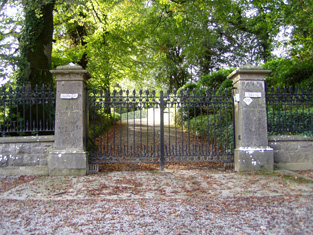
|
| Tubbrid | Laurence Walsh occupied a house valued at £11.10 shillings and held from Lord Waterpark in the mid 19th century. This house still functions as a farm house. |

|
| Castlegrace | This property has been the home of the Grubb family since the mid 19th century. Griffith's Valuation indicates that it was then held from the Earl of Glengall and the house, offices and flour mill were valued at £122. The National Inventory of Architectural Heritage dates the present house circa 1860 although a lithograph of a very similar building is included in the Glengall sale rental of November 1853 for Castlegrace. Lewis records in 1837 that an extensive flour mill had recently been built by Samuel Grubb of Clogheen. The buildings at Castlegrace were valued at £115 in 1906. This house is still a Grubb family home. http://www.vee.ie/page2.html |

|
| Shanbally Castle | Bence Jones writes that this was the largest of John Nash's Irish castles, built circa 1812 for Cornelius O'Callaghan 1st Viscount Lismore. It was valued at £151 in the mid 19th century. Inherited by two daughters of the Marquess of Ormonde Lady Beatrice Pole Carew and Lady Constance Butler following the death of their cousin the 2nd and last Viscount Lismore in 1898. The Irish Tourist Association Survey in the early 1940s records that the building was taken over by the military authorities "for the duration of the present emergency". Sold by Major Patrick Pole Carew in 1954 and demolished in 1957. |

|
| Shanbally | In 1786 Wilson refers to Shanbally as a seat of Viscount Lismore. It was occupied by John Mahoney and valued at £10.15 shillings at the time of Griffith's Valuation, held from Viscount Lismore. In 1894 Slater refers to it as a residence of Viscount Lismore. | |
| Ballyboy | The residence of John Travers in 1814, of R. Croker in 1837 and vacant in the early 1850s when it was held by James Fennessy from Viscount Lismore. A house and farm are still extant at the site. | |
| Rehill | Rehill was occupied by William Fennell in 1814 and 1837 but by the time of Griffith's Valuation James Mulcahy was resident, holding the property from the Earl of Glengall. The buildings which included a house, offices and corn mill were valued at £62. Sold in 1853 to Robert Murdock and leased by him to Edward Mulcahy. A building is still located as this site. | |
| Garryroan House | Robert Fennell occupied this house in 1814 and Joseph R. Fennell at the time of Griffith's Valuation, when the buildings were valued at £14 and held from Lord Waterpark. This was still a Fennell home in the 1870s and continues to be a family residence. In 2012 it was offered for sale. |

|
| Galtee Castle | Built in the late 18th century as a hunting lodge, it was described in the Kingston sale rental of July 1851 as a "handsome cut stone building, erected in a tasteful style of architecture, with suitable offices .... beautifully situated in the curve of a well planted glen..". Located close to the eastern bank of the Attychraan River at the base of the southern slope of the Galty Mountains, this house was occupied by James Law in the mid 19th century, valued at £29+ and held by him in fee. Noted by Slater in 1894 as the home of Nathaniel Buckley and of Abel Buckley in 1906 when the buildings were valued at £130. The house is no longer extant. Also known as Mountain Lodge. | |
| Scart | The residence of Robert Croker in 1814 and of Henry Rice in 1837. The Ordnance Survey Name Books refer to it as his residence in 1840, "pleasantly situated on rising ground and in good repair". In the early 1850s Rice held the property from John Bagwell and the buildings were valued at £12+. Henry Rice may have been a son-in-law of Robert Croker. see http://members.iinet.net.au/~nickred/croker_research/The_Irish_CROKER.pdf A building is still located at this site. | |
| Millgrove House | Thomas Jackson occupied this house in 1814 and William Walpole in the 1850s. Walpole held the property from Lord Waterpark and the house, office and corn mill were valued at £38. This house has recently been renovated. |
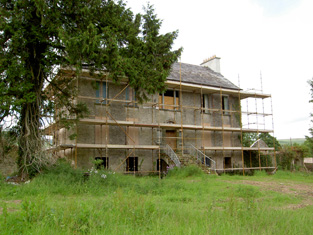
|
| Tincurry House | Abraham Jackson was residing at Tincurry in 1814. The Ordnance Survey Name Books refer to Tincurry as the residence of Stephen Moore in 1840. The building appears to have been in use as a workhouse at the time of Griffith's Valuation. In 1906 Wiliam Jackson Pigott was resident at Tincurry in a house valued at £23+. The National Inventory of Architectural Heritage states that the present house was built in 1932 on the same site as the original house which was blown up by British Forces in 1921. |

|
| Elgin Cottage | In 1851 this property was leased by Georgiana Gumbleton to Edmund Barry when it was valued at £10. It was built after the 1st edition Ordnance map and is labelled Elgin Cottage on the 25-inch edition of the 1890s. There is still an extant house at the site. | |
| Marshtown House | Held in fee by R.H. Gumbleton at the time of Griffith's Valuation, when it was valued at £8 10s. The property is labelled Marshtown House on the 1st editon Ordnance Map but is not labelled on the later 25-inch edition. Marston House (W950987), in the adjacent townland of Marshtown, is shown on the 25-inch map of the 1890s but there is no trace remaining. | |
| Cloonbeg | A property described as offices, the property of R.H. Gumbleton, was valued at £15 5s at the time of Griffith's Valuation. In 1906 this property was owned by Basil Orpin with a valuation of £16. Some of the buildings still remain at the site. | |
| Ballyduff Castle Farm | Described as Ballyduff Castle (in ruins) on the 1st edition Ordnance Survey map, these buildings were valued at £11 15s at the time of Griffith's Valuation. They were being leased by Edward Walsh from the Musgrave estate. The National Inventory of Architectural Heritage suggests the house was built c.1825. The ruined fortified house at the site dates from the early seventeenth century. |
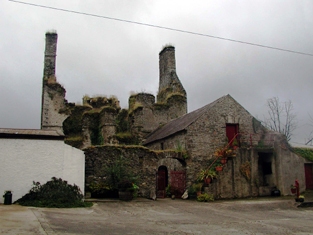
|
| Mocollop Castle | Mocollop Castle was in ruins by the time of Griffith's Valuation, though buildings at the site were valued at £31. They were held in fee by Captain James Barry. In 1786, Wilson refers to it as the seat of Dr. Drew. In 1906 the buildings at this location were in the possession of Henry Drew, MD, and valued at £32. The National Inventory of Architectural Heritage reports that the buildings there were in ruins in the early part of the 21st century. |

|
| Clashleigh | Lewis records Claishleigh as the residence of S. Grubb and in Griffith's Valuation Samuel Grubb held a house, office and flour mill valued at £170 in Clogheen Market from Viscount Lismore. His son Henry Samuel Grubb lived at Claishleigh in the 1870s. This house was in use as a rectory in the 20th century. |

|
| Coolville | An early 19th century house, occupied by Richard Grubb in the first half of that century. It was held from Viscount Lismore and with offices and flour mills was valued at £169 in the early 1850s. Home of Edward Sackville West 5th Lord Sackville in the mid 20th century, who added a Gothic conservatory to the building. |

|
| Kilcoran Lodge | A house built in the second half of the 19th century, valued at £46.10 shillings in 1906, the property of Robert Murdock. | |
| Mountain Lodge | In the mid 19th century Viscount Lismore owned a house/hunting lodge valued at £7 in the townland of Cullenagh (2,740 acres) which he also owned. This building has since been extended and is still in use as a youth hostel. |

|
| Ballybeg (Mitchelstown) | In 1786 Wilson states that "Ballybeg, the seat of Mr. Spratt, was pleasantly situated at the foot of a lofty mountain" outside Mitchelstown. Local history suggests that this was a property acquired by Devereux Spratt in the 17th century. It is not named on the 1st edition Ordnance survey map though buildings are shown at the site. | |
| Kilshanny | Wilson, writing in 1786, refers to Kilshanan as the seat of Captain King. An unnamed property is shown in the townland of Kilshanny on the 1st edition Ordnance Survey map which was later to be the site of Mitchelstown workhouse. It is no longer extant. |

